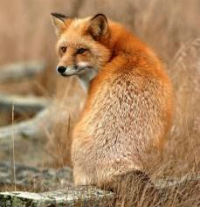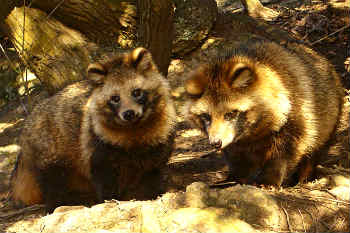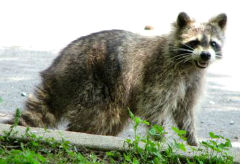Fox/Raccoon Dog Hybrids
EUGENE M. MCCARTHY, PHD GENETICS
 Red Fox (Vulpes vulpes)
Image: Wikipedia, Minette Layne
Red Fox (Vulpes vulpes)
Image: Wikipedia, Minette Layne
 Two raccoon dogs (Nyctereutes procyonoides) Image: Wikimedia (663highland).
Two raccoon dogs (Nyctereutes procyonoides) Image: Wikimedia (663highland).
A 2012 BBC article, pictures and describes a black, fox-like animal captured in the UK. According to the story, biologist “Helen McRobie, from Anglia Ruskin University in Cambridge, said genetic mutations suggested it may be a hybrid between a silver fox and raccoon dog” (Silver fox is a synonym of red fox). The story goes on to say the following:
Mrs McRobie, a biomedical scientist, and technician Angela Wheatley, carried out a number of genetic tests when the animal was brought into their laboratory.
“Analysis of a key pigmentation gene revealed two new mutations that have not yet been described in scientific literature,” Mrs McRobie said.
“More surprisingly, it revealed that they were a very close match to the same gene found in the raccoon dog.”
Raccoon dogs are similar to foxes, but have shorter limbs.
“They have been farmed with silver foxes in Russia and it seems that a hybridisation between the two species may possibly have occurred from a mating,” she said.

|
|
Northern Raccoon (Procyon lotor) |
Though native to eastern Asia, raccoon dogs have been introduced widely in Europe. Wild raccoon dogs have been captured in England (Nowak 1999, p. 653). They are also sold as exotic pets there, and no doubt escape occasionally, but they seem to be quite rare. So it's also conceivable that this alleged hybrid is the product of a natural mating between a raccoon dog (which could not find a mate of its own kind) and a native red fox.
Nyctereutes: Inconsistent taxonomic classification. Raccoon dogs are very similar in appearance to the North American raccoon, a member of the mammalian family Procyonidae (i.e., a “procyonid”), which prompted their inclusion in that family in certain past taxonomic classifications. The specific name of the raccoon dog, procyonoides, literally means “similar to a raccoon,” which is obviously the case (see images), and its very name, raccoon dog, indicates that it has traits of both raccoon and dog. Raccoon dogs are currently assigned to Canidae, the same family as dogs, wolves and foxes. But they don't fit in well there. Ward and Wurster-Hill (1990, p.5) note that
| The taxonomic position of Nyctereutes is unclear. Frechkop (1959) placed the genus with the procyonids, but Van Gelder (1978) recognized it as a distinctive canid genus [i.e., assigned it to Family Canidae]. Its phylogenetic relationships within the Canidae are not well-resolved. It shows no close affinities with other canid genera. This was confirmed in an analysis of 36 canid species using numerical methods and 90 morphological and behavioral characters (Clutton-Brock et al., 1976). On two-dimensional plots and centroid-linkage dendrograms, the raccoon dog was always an outsider, and exhibited a similarity value of < 75 with Canis, Vulpes, and Dusicyon. |
|
Diploid chromosome counts. At least two distinct populations of raccoon dogs are known, each having its own characteristic chromosome count. Ward and Wurster-Hill (1990, p. 5) state that
Two diploid numbers are found in raccoon dogs with varying numbers of associated supernumerary or B chromosomes (Ward et al., 1987). N. p. viverrinus has 2n=38 + Bs, including 13 pairs of biarmed and five pairs of acrocentric autosomes, and from one to four small B chromosomes. N. p. procyonoides has 2n=54 + Bs, including five pairs of biarmed and 21 pairs of acrocentric autosomes, and from one to three medium-sized B chromosomes. The sex chromosomes of each subspecies are a medium-sized X and a tiny metacentric or submetacentric Y.
B chromosomes are small chromosomes. Different individuals within the same population may have differing numbers of B chromosomes in their karyotypes, which indicates their presence is unnecessary for life. B chromosomes are also known as supernumerary or accessory chromosomes. Larivière and Pasitschniak-Arts (1996, p. 6) state that the red fox has a diploid number of 34 chromosomes and 3-5 supernumeraries. |
A point to investigate. There is also an old report of a hybrid between raccoon and fox, but in that case no genetic analysis was carried out. Given that report, and the present case of an ostensible hybrid between fox and raccoon dog, it seems it would be interesting to look into the possibility that the raccoon dog, which is intermediate in appearance between foxes and raccoons, might be the product of hybridization between foxes and raccoons. This hypothesis is also consistent with the fact that raccoon dogs have a taxonomic history in which they have, at different times, been placed either in Canidae or Procyonidae.
According to Nowak (1999), in the northern, colder regions of their ranges both raccoons and raccoon dogs spend weeks or months sleeping in their dens, but both wake on warm days to forage and return to their dens to sleep when temperatures drop again. Nowak (1999, p. 652) also notes that “Nyctereutes is the canid that hibernates.” So this seems to be another trait, beyond the striking similarity in general appearance, that connects raccoon dogs with raccoons.
By the same author: Handbook of Avian Hybrids of the World, Oxford University Press (2006).